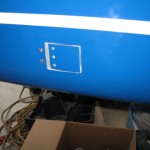Sep
18
2009
Spent the first part of the day ordering supplies from ACS which I dont like to do. It is not the cost of the parts, but the shipping that kills me. I usually try to order a bunch of stuff at one time to reduce the costs. Work continues on the new prototype oil sump. The fuel servo is mounted and positioning is much better than the first oil sump.
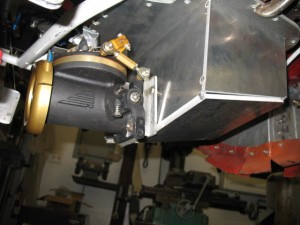
The servo is tilted down which helps with angle of the air tube.
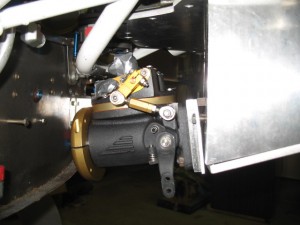
The nice feature of this setup is I only have one bell crank for the mixture which actually uses the fuel servo shaft as a support. I dont have to weld on any additional brackets for the bell crank. Mounted is a temporary bell crank which will do fine until I get my bearings in to make the permanent one.
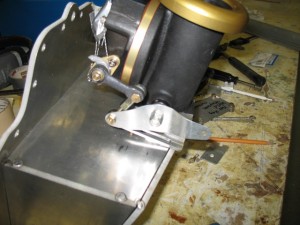
This is where the Pmag coils will mount. I made a weld template so the fabricator which will ensure the hole spacing is exactly right otherwise the coil mounting will have a problem. Only a few more parts to locate and then I’ll start welding brackets onto the pan.
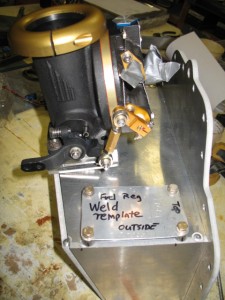
Hrs worked 7.4
Sep
16
2009
The heat duct system is now complete. It is very cool how the distibution tube snakes around in order to accomplish its’ job. Total weight (fan, heater core, ducts) is 5.5 lbs. I’ll have to add in the weight of the hoses later.
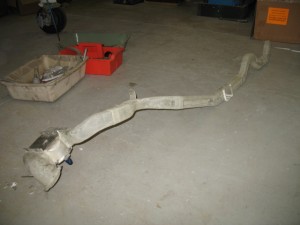
The new oil pan protype has arrived from Calif. The vender did a VERY nice job with the abrasive cutter of the plates. All holes match perfectly.
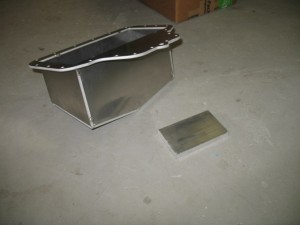
Tomorrow the real fun begins. I have remount everything on to this pan that was already fitted to the first pan. Overall, since I have more flexibility on placement of components, this pan should turn out to be much nicer, cleaner installation than the first one I did (although it wont look as cool).
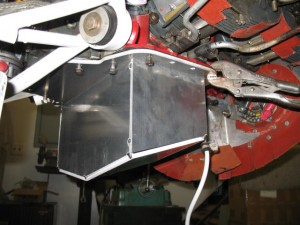
4.7 hrs worked.
Sep
15
2009
The drain line hole has been back filled. Now it is time to plant some grass seed and add some fill to level the yard out a bit.
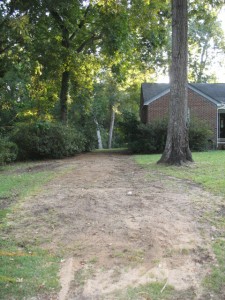
Tony Cole stopped by today to bring over his HID light he purchased for an amazing $50 for two. Came direct from China. We had to run a side by side test against the HID light sold in Aircraft Spruce for $450.
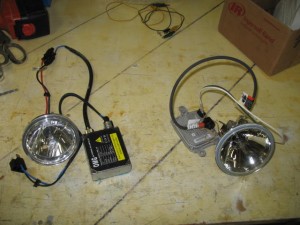
First thing you notice is the weight. The China one 498 grams and the ACS one is 383 gm.
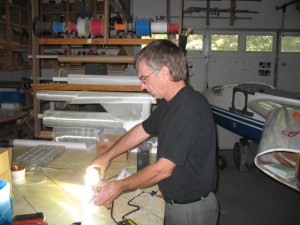
When Tony powered them up although they had the same rating (35 watts), the ACS model had a much tighter, brighter beam. Like a spotlight should be. The ACS HID light color was warmer than the cooler, bluer (6000 Kelvin) look of the China model.
The China HID used a reflector meant for a motorcycle which spread out quite a bit and could be used as a taxi light. While cheap, I would deem it not good for a landing light and the only place I would use it would be for a taxi light.
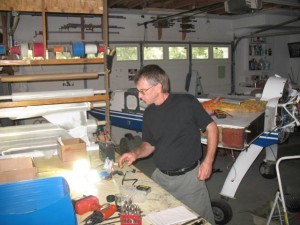
I did some research on the ACS HID light and found it is actually made a re-purposed light from Speaker Model Model 9440LS-12V 35W retrofit light. I found the OSRAM ballast for $75, and the bulb for about $60, I couldn’t find a proper reflector. Finding a supplier for the Speaker model above would be the best solution. One could call the company. Overall, in some ways I fail to see why anyone would want HID lights in a plane that cost half a grand. I have a $20 aviation bulb in my plane, and while not the brightest on the block has worked well for 8 years. It take more power, a little heaver wire, but it works and is cheap.
Today’s efforts was concentrated on finishing up the nose lift cover (which I cut into 3 sections), installing nut plates, glassing heat ducting and manufacturing the mounting brackets for the EFIS AHRS (gyro).
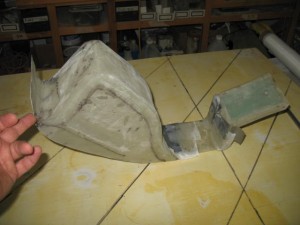
Worked 6.5 hrs.
Sep
14
2009
While working on the heating system installing screw plates which will hold everything together, I found the nose lift cover I made would not come out with the duct system installed.
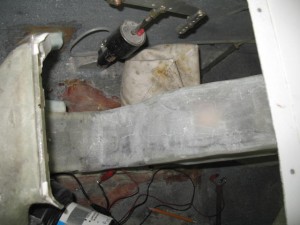
This is intolerable as I would hate to have to take the heating system appart just to service the nose lift. I ended up splitting the cover to make servicing easier. It is now been cut and re-glassed. Tomorrow, I’ll install the nut plates to hold it together.
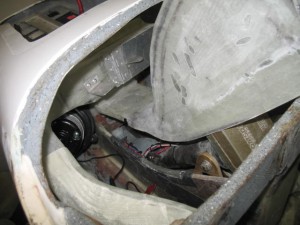
I also took appart the control linkage system in order to install the new NACA duct system for cabin presurization and ventilation. I had to get access to the area so the tubes had to go….
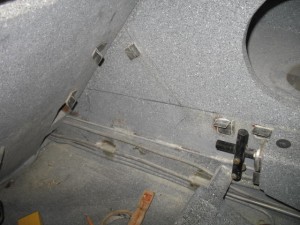
I plan to try and install the entire NACA duct from the inside of the plane to eliminate the filling and re-contouring of the outside of the plane. This is going to be a challenge! The ice pick is a locator which indicates where to mark and cut the outside of the plane.
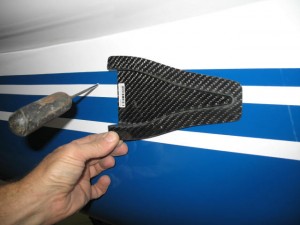
Total time worked today 2.6 hrs.
Sep
09
2009
Work continues on the heat system. I tested the overboard heat dump yesterday when I assembled the entire duct system. It worked GREAT! The amount of air flowing out the valve was quite a bit and almost no air flowed to the back seat. Just as I had hoped for.
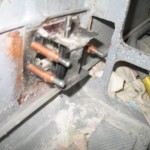
Heat valve being floxed to the interior wall
Just a little more to do on the heat duct and then I’ll be working on the nose lift cover.
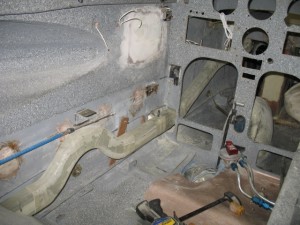
Heat duct system
Jul
22
2009
A few interesting notes for today. I wanted to make a way to center and align fuse blocks on to the covers. I found you can just wax the holes, put some flox in them and clamp them to the panel. After curing the block will now be held in perfect alignment relative to the slots.

After milling the slots (a major PITA) I felt there had to be a better way. I took some Shape Lock molded the openings in the fuse block,

Glassed (3 layers) and vacuumed everything down to the table,


When cured, removed the shape lock, sanded the high spots, and ended up with a perfect match for the slots. MUCH quicker than milling slots (especially for a 20 fuse base). I learned that I needed to coat the shape lock with mold release as it was tough to get the glass to release. Overall, I am very happy with the first try.


This technique would make it easy to make covers for the fuse blocks to protect the wires and to have a place to attach lables to identy the fuses.

Jack came over with his new rotary lock design to eliminate the canopy access door.

Yesterday, I glassed the door shut and removed the hard ware. Installation was extremely easy. A couple of holes in the longeron’s and it bolted right into the airplane. I’ll take some foam and fill the old door opening and extend the shaft to the outer fuselage to allow a exterior key to be used.


Also worked on the back trim panels and some map pockets.

7.3 hrs worked today
Jun
12
2009
Today was spend on designing the instrument panel. Talk about stuffing 5 gallons of sh*t in a 1 gallon bucket! If you just look at the indiviual components, it looks absoultely impossible to fit everything into the space I have to work with. There is something to be said about computer modeling!
Fortunately the GRT has inputs for alarms hich will eliminate all warning lights on the dash.
I cant wait to start cutting out the panel…
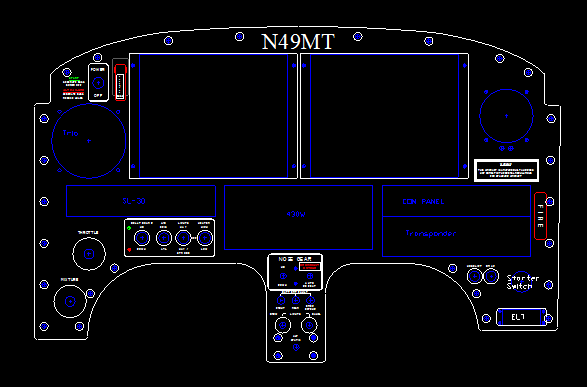
Jun
09
2009
Summary of the next few days of work. Boring stuff, researching parts and looking through catalogs.
-
Ordered a bunch of electric parts and the RAM mounts.
-
Went to the machine shop to check on the sump…. not done. Not even started. I threatened to take to another shop and the owner promised to get started on it immediately.
-
Got the paint on the plane coded so I could get it mixed. The gray is matched exactly to the gray interior vinyl and will be used on the instrument panel. Blue and white match the exiting colors.
-
Worked on ACAD panel design.
-
Worked on the electrical system. Some of the parts I wanted to use would not fit in the panel. So I had to search again for smaller switches.

















